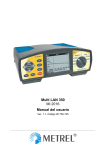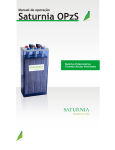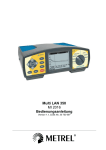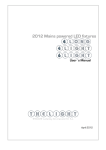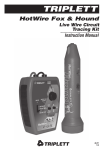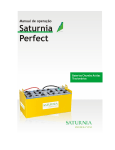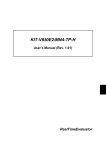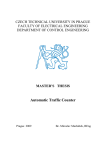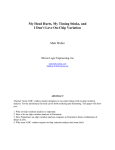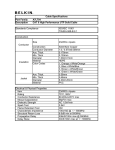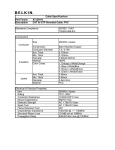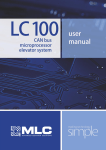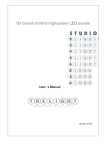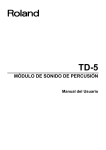Download Multi LAN 350 MI 2016 User Manual
Transcript
Multi LAN 350 MI 2016 User Manual Version 2.2, Code No. 20 750 745 Distributor: Producer: METREL d.d. Ljubljanska cesta 77 SI-1354 Horjul Tel.: +386 1 75 58 200 Fax: +386 1 75 49 226 E-mail: [email protected] http://www.metrel.si Mark on your equipment certifies that this equipment meets the requirements of the EU (European Union) concerning safety and electromagnetic compatibility regulations. © 2003, 2005 Metrel No part of this publication may be reproduced or utilised in any form or by any means without permission in writing from METREL. 2 MI 2016 Multi LAN 350 Table of contents 1 Multi LAN 350 --------------------------------------------------------------------------------------- 6 2 General information------------------------------------------------------------------------------- 7 2.1 Safety and operational precautions --------------------------------------------------------- 7 2.1.1 Warnings ------------------------------------------------------------------------------------- 7 2.1.2 Batteries -------------------------------------------------------------------------------------- 7 2.1.3 Power supply considerations ------------------------------------------------------------ 8 2.1.4 Factory Calibration, Self Calibration --------------------------------------------------- 9 2.1.5 Service ---------------------------------------------------------------------------------------- 9 2.2 Description -------------------------------------------------------------------------------------- 10 2.2.1 Instrument MultiLAN 350 --------------------------------------------------------------- 10 2.2.1.1 Front panel --------------------------------------------------------------------------- 10 2.2.1.2 Connector panel -------------------------------------------------------------------- 11 2.2.1.3 Bottom--------------------------------------------------------------------------------- 12 2.2.2 Remote unit MultiLAN 350 RU -------------------------------------------------------- 12 2.2.2.1 Remote unit connector panel ---------------------------------------------------- 13 2.2.3 Permanent Link adapter ---------------------------------------------------------------- 13 2.2.4 Channel Link adapter-------------------------------------------------------------------- 14 2.2.5 ATTENUATION Calibration module ------------------------------------------------- 14 2.2.6 IR adapter for testing fiber cables ---------------------------------------------------- 14 3 Specifications ------------------------------------------------------------------------------------- 15 3.1 Standard set (Ordering code MI 2016 ST) ---------------------------------------------- 15 3.2 Professional set (Ordering code MI 2016 PS)------------------------------------------ 15 3.3 Optional accessories ------------------------------------------------------------------------- 15 3.4 Technical specifications --------------------------------------------------------------------- 16 3.4.1 Length --------------------------------------------------------------------------------------- 16 3.4.2 Propagation Delay ----------------------------------------------------------------------- 16 3.4.3 Delay skew--------------------------------------------------------------------------------- 16 3.4.4 Characteristic Impedance -------------------------------------------------------------- 16 3.4.5 DC Resistance ---------------------------------------------------------------------------- 16 3.4.6 Attenuation --------------------------------------------------------------------------------- 17 3.4.7 NEXT, Remote NEXT ------------------------------------------------------------------- 17 3.4.8 PSNEXT, Remote PSNEXT ----------------------------------------------------------- 17 3.4.9 ELFEXT, Remote ELFEXT------------------------------------------------------------- 17 3.4.10 PSELFEXT--------------------------------------------------------------------------------- 18 3.4.11 Return Loss, Remote Return Loss --------------------------------------------------- 18 3.4.12 ACR, Remote ACR ---------------------------------------------------------------------- 18 3.4.13 PSACR, Remote PSACR--------------------------------------------------------------- 18 3.4.14 TDR (Time Domain Reflectometer) -------------------------------------------------- 18 3.4.15 Time Domain Crosstalk ----------------------------------------------------------------- 19 4 General specifications ------------------------------------------------------------------------- 20 4.1 General Data ----------------------------------------------------------------------------------- 20 5 Multi LAN 350 Operation ---------------------------------------------------------------------- 21 5.1 Test connections ------------------------------------------------------------------------------ 21 5.1.1 Permanent link connection ------------------------------------------------------------- 21 5.1.2 Channel connection---------------------------------------------------------------------- 22 5.1.3 Basic link connection -------------------------------------------------------------------- 23 5.1.4 Optical fiber connection ----------------------------------------------------------------- 23 5.2 Presentation of results ----------------------------------------------------------------------- 23 3 MI 2016 Multi LAN 350 Table of contents 5.2.1 Summary results - Copper cables---------------------------------------------------- 23 5.2.2 PASS / FAIL decistions ----------------------------------------------------------------- 24 5.2.3 Detailed measuring results, information on plots and cursors----------------- 26 5.2.4 Summary result - Optical fiber--------------------------------------------------------- 26 5.3 Single test --------------------------------------------------------------------------------------- 26 5.3.1 Wire map ----------------------------------------------------------------------------------- 27 5.3.2 PSNEXT, Remote PSNEXT ----------------------------------------------------------- 29 5.3.3 NEXT, Remote NEXT ------------------------------------------------------------------- 31 5.3.4 ELFEXT, Remote ELFEXT------------------------------------------------------------- 32 5.3.5 PSELFEXT, Remote PSELFEXT----------------------------------------------------- 34 5.3.6 RETURN LOSS, Remote RETURN LOSS----------------------------------------- 35 5.3.7 Attenuation --------------------------------------------------------------------------------- 37 5.3.8 PSACR, Remote PSACR--------------------------------------------------------------- 38 5.3.9 ACR, Remote ACR ---------------------------------------------------------------------- 40 5.3.10 Length --------------------------------------------------------------------------------------- 41 5.3.11 Delay Skew -------------------------------------------------------------------------------- 42 5.3.12 Propagation Delay ----------------------------------------------------------------------- 42 5.3.13 Impedance --------------------------------------------------------------------------------- 43 5.3.14 DC Resistance ---------------------------------------------------------------------------- 44 5.4 Scope functions-------------------------------------------------------------------------------- 44 5.4.1 Background of TDR and TDnext------------------------------------------------------ 44 5.4.2 Scope Test procedure------------------------------------------------------------------- 46 5.5 Autotest - copper cables--------------------------------------------------------------------- 47 5.5.1 Complete, Near End, Far End Autotest --------------------------------------------- 48 5.5.2 Selecting the Autotest Type------------------------------------------------------------ 49 5.5.3 Testing procedure ------------------------------------------------------------------------ 50 5.6 Autotest - fiber optic -------------------------------------------------------------------------- 51 5.6.1 Types of testing - configurations------------------------------------------------------ 51 5.6.2 Testing procedure ------------------------------------------------------------------------ 52 5.7 Setting copper cable standard ------------------------------------------------------------- 55 5.7.1 Test standard selection ----------------------------------------------------------------- 55 5.7.2 Cable type selection --------------------------------------------------------------------- 55 5.7.3 Setting cable NVP ------------------------------------------------------------------------ 56 5.7.4 Autotest sequence configuration ----------------------------------------------------- 56 5.8 Setting optical fiber cable standard ------------------------------------------------------- 57 5.8.1 Optical fiber test standard selection ------------------------------------------------- 57 5.8.2 Cable type selection --------------------------------------------------------------------- 58 5.9 Talk & trace interface------------------------------------------------------------------------- 59 5.9.1 Establishing a voice communication------------------------------------------------- 59 5.9.2 Breaking off the connection ------------------------------------------------------------ 59 5.9.3 Locating cables --------------------------------------------------------------------------- 59 5.9.4 Remote-------------------------------------------------------------------------------------- 60 5.10 Locator ------------------------------------------------------------------------------------------- 61 5.11 Memorizing results ---------------------------------------------------------------------------- 61 5.11.1 Saving the latest PLOTS --------------------------------------------------------------- 62 5.11.2 Saving Complete Autotest / Near End Autotest / Remote Autotest results 62 5.11.3 Downloading data / results to PC----------------------------------------------------- 64 5.12 Remote unit MultiLAN 350 RU operation------------------------------------------------ 64 5.13 Settings ------------------------------------------------------------------------------------------ 65 5.13.1 Language selection ---------------------------------------------------------------------- 66 4 MI 2016 Multi LAN 350 Table of contents 5.13.2 Calibration---------------------------------------------------------------------------------- 66 5.13.3 Recall Autotest ---------------------------------------------------------------------------- 66 5.13.4 Clear Autotest ----------------------------------------------------------------------------- 67 5.13.5 Clear Memory ----------------------------------------------------------------------------- 67 5.13.6 Battery Test -------------------------------------------------------------------------------- 67 5.13.7 Set Date/Time ----------------------------------------------------------------------------- 68 5.13.8 Backlight mode---------------------------------------------------------------------------- 68 5.13.9 Noise Filter --------------------------------------------------------------------------------- 68 5.13.10 Cable Type --------------------------------------------------------------------------- 69 5.13.11 Initial settings ------------------------------------------------------------------------ 70 5.13.12 Factory settings --------------------------------------------------------------------- 70 5.13.13 COM port ----------------------------------------------------------------------------- 70 5.14 HELP function ---------------------------------------------------------------------------------- 71 6 LAN Link Software package ------------------------------------------------------------------ 72 6.1 Creating test reports -------------------------------------------------------------------------- 73 6.1.1 Defining original location names------------------------------------------------------ 73 6.1.2 Adding operator/test site header and comments --------------------------------- 73 6.1.3 Selecting complexity of Test Reports------------------------------------------------ 73 6.1.4 Viewing Plots ------------------------------------------------------------------------------ 73 6.1.5 Saving Autotest Result or Plots for Documentation Purposes ---------------- 74 6.2 Printing out a test report or plot ------------------------------------------------------------ 75 7 INDEX ------------------------------------------------------------------------------------------------ 76 5 MI 2016 Multi LAN 350 Multi LAN 350 1 Multi LAN 350 Multi LAN 350 is a portable cable tester for complete testing and verification of LAN cabling up to 350MHz. Main features • • • • • • • • • • • • Complete function set needed for verification of LAN cabling, including Cat 6 / Class E installations. Powerful troubleshooting tools such as high resolution TDR and TDCrosstalk Supports UTP, STP, ScTP and FTP cables, Permanent and Channel link testing Supports fiber optic cable testing in combination with compatible Optical testing instrumentation, eg. Optical Power Meter PM420. 2 way Autotest function for fast and reliable testing Talk & Trace interface provides full duplex communication and is also intended for locating cables Locators for locating cables Main test standards and cable types (copper and fiber) are preprogrammed Large memory capacity for storing measured data Powerful Windows software for data analysis and Test report evaluation Graphical representation of results on instrument's display and PC Simple firmware upgrading This manual provides information for connection, operation, test procedures and maintainance of the Multi LAN 350. The manual is divided into five sections, each covering a particular aspect of the operation. 6 Multi LAN 350 General information 2 General information 2.1 Safety and operational precautions 2.1.1 Warnings To ensure a high level of operator's safety while carrying out various measurements and tests using the Multi LAN 350 and MultiLAN350 RU, as well as ensuring that the test equipment remains undamaged, it is necessary to consider the following general warnings: The test equipment is intended for / to be used (safety extra low voltage) environment only. Do not connect the instrument to public telephone network! Never connect the test equipment to an active network. Service is allowed to be carried out only by an authorised person! Use only standard or optional test accessories supplied by your distributor! Use only connector types equivalent to those built in the instrument to avoid damage to the instrument components. 2.1.2 Batteries Replacement Note Insert cells correctly, otherwise the instrument will not operate and the batteries could be discharged. If the instrument is not to be used for a long period of time remove all batteries from the battery compartment. Warnings! When battery cells have to be replaced, before opening battery cover disconnect any measuring accessory connected to the instrument and turn power off on the instrument. Use only power supply /charger delivered from manufacturer or distributor of the test equipment to avoid possible fire or electric shock. The real time clock setup will be lost if the batteries are removed for more than 15 minutes ! Stored measurement graphs will be lost immediately after the batteries are removed. Precautions on charging of new batteries or batteries unused for a longer period Unpredictable chemical processes can occur during charging of new batteries or batteries that were unused for a longer period of time (more than 3 months). NiMH and NiCd batteries are affected to a various degree (sometimes called as memory effect). 7 Multi LAN 350 General information As a result the instrument operation time can be significantly reduced at the initial charging/discharging cycles. Therefore it is recommended: - To completely charge the batteries (at least 14h with in built charger). - To completely discharge the batteries (can be performed with normal working with the instrument). - Repeating the charge/discharge cycle for at least two times (four cycles are recommended). When using external intelligent battery chargers one complete discharging /charging cycle is performed automatically. After performing this procedure a normal battery capacity is restored. The operation time of the instrument now meets the data in the technical specifications. Notes The charger in the instrument is a pack cell charger. This means that the batteries are connected in series during the charging so all batteries must be in similar shape (similarly charged, same type and age). Even one deteriorated battery (or just of an another type) can cause an improper charging of the entire battery pack (heating of the battery pack, significantly decreased operation time). If no improvement is achieved after performing several charging /discharging cycles the shape of individual batteries should be determined (by comparing battery voltages, checking them in a cell charger etc). It is very likely that only some of the batteries are deterirated. The effects described above should not be mixed with normal battery capacity decrease over time. All charging batteries lose some of their capacity when repeatedly charged/discharged. The actual decrease of capacity versus number of charging cycles depends on battery type and is provided in the technical specification from battery manufacturer. Information on batteries Only rechargeable NiMH batteries (size C) can be used. The operating hours are given for a nominal capacity of 3500 mAh. Do not use standard batteries ! 2.1.3 Power supply considerations When using the original power supply adapter / charger A1135 the instrument is fully operational immediately after switching it on. The batteries are charged at the same time, nominal charging time is 16 hours. The batteries are charged whenever the power supply/charger is connected to the instrument. Inbuilt protection circuits control the charging procedure and assure maximal battery lifetime. 8 Multi LAN 350 General information 2.1.4 Factory Calibration, Self Calibration Factory Calibration It is essential, that all measuring instruments are regularly calibrated. For occasional daily use, we recommend an annual factory calibration to be carried out. When the instrument is used continuously every day, we recommend a factory calibration every sixth months. Contact the manufacturer or your local distributor for further information. Self Calibration (with the Attenuation calibration module ) The test calibration serves to perform a fast check up of the instrument and remote unit hardware. If using an other remote unit as delivered it is obligatory to perform it. The calibration can be performed with the Attenuation calibration module ACM-350. When the instrument is used continuously every day we recommend to perform self calibration at at least once per month. The user should run it at least one per month. Note: The main and remote unit should be switched on at least 1 minute before performing the self calibration. The self calibration should be performed at room temperature. 2.1.5 Service For repairs under or out of warranty time please contact your distributor for further information. Name and address of manufacturer METREL d.d. Ljubljanska cesta 77 SI-1354 Horjul Tel.: +386 1 75 58 200, fax.: +386 1 75 49 226, +386 1 75 49 206) http://www.metrel.si E-mail: [email protected] 9 Multi LAN 350 General information 2.2 Description 2.2.1 Instrument MultiLAN 350 2.2.1.1 Front panel FUNCTION SWITCH KEYPAD EXT.INPUT LCD Front panel layout Function switch selects one of eight fuctional/operating menus: Functional Menu SETTINGS STANDARD AUTOTEST SINGLETEST SCOPE LOCATOR REMOTE Description adjustment of system parameters, such as time, RS232 settings etc. selection of test standard,cable type, test procedures performs predefined Autotests performs single tests in full detail high resolution time domain reflectometer special mode for tracing cables and sockets with locators the instrument is used as a Remote unit; far end measurements are enabled 10 Multi LAN 350 General information Front panel keypad ESC ……………................Return to previous page in menu HELP…………..................On Line information and warnings ON/OFF…. ……...............To turn on or off the instrument (Auto off after 10 minutes) TALK…………..................Talk & Trace interface for talking over cable LIGHT…………................Two level LCD backlight normal/ bright/ OFF backlight automatically turns OFF after 30s if no keys used LIGHT + right arrow…......Increase display contrast LIGHT + left arrow..….......Decrease display contrast ARROW keys………….....Move cursor and select parameters ENTER….. …………….....Starts test procedures, confirmation of selected items SAVE………………….......Memorizing Autotest results LCD…………………….....Graphic display with backlight, 320x240 dots CHARGER INPUT……....To connect the charger/power supply 2.2.1.2 Connector panel 1. Baseline interface connector 2. Audio jack: Microphone input 3. Audio jack: Phone output 4. RS232 connector 5. USB connector 4 1 5 2 3 11 Multi LAN 350 General information 2.2.1.3 Bottom Bottom View Layout 1. Nylon strap (allows the instrument to be slung round the neck) 2. Plastic cover (fixes nylon strap to the instrument). There is a screw under this cover which needs to be unscrewed when opening the instrument for service and calibration purposes. 3. Screw (unscrew to remove carrying strip or to open the instrument) 4. Information label 5. Battery compartment cover 6. Retaining screw (unsrew to replace batteries) 7. Rubber foot 2.2.2 Remote unit MultiLAN 350 RU Front panel keypad ON/OFF…. ……………To turn the instrument on or off (Auto off after 10 minutes) 12 Multi LAN 350 General information Meaning of LEDs TESTING ……………On: testing in progress TALK ….......…….…..On: talk & trace mode POWER ……….....…On: Power on LOW BAT……………Empty battery PASS……….….........Autotest passed FAIL…………..............Autotest failed 2.2.2.1 Remote unit connector panel 1. Baseline interface connector 2. Audio jack: Microphone input 3. Audio jack: Phone output 4. RS232 connector 4 1 2 3 2.2.3 Permanent Link adapter 2 1 1. High performance CAT6 RJ45 plug 2. Baseline interface plug 13 Multi LAN 350 General information 2.2.4 Channel Link adapter 2 1 1. High Quality CAT6 RJ45 jack 2. Baseline interface plug 2.2.5 ATTENUATION Calibration module 2.2.6 IR adapter for testing fiber cables 2 1 1. IR receiver 2. Baseline interface plug 14 Multi LAN 350 Specifications 3 Specifications 3.1 Standard set (Ordering code MI 2016 ST) Instrument MultiLAN 350 Remote unit MultiLAN 350 RU Permanent Link Adapter, 2 pcs Channel Link Adapter, 2 pcs Carrying bag 2 pcs LANlink PC Software RS 232 cable USB cable User Manual Locator set I (#1.-.#4) Attenuation Calibration module Power supply / adapter Headphones set, 2 pcs NiMH battery pack 12 pcs 3.2 Professional set (Ordering code MI 2016 PS) Instrument MultiLAN 350, 2 pcs Permanent Link Adapter, 2 pcs Channel Link Adapter, 2 pcs Carrying bag 2 pcs LANlink PC Software RS 232 cable USB cable User Manual Locator set I (#1.-.#4) Attenuation Calibration module Power supply / adapter, 2 pcs Headphones set, 2 pcs NiMH battery pack 12 pcs 3.3 Optional accessories Power supply / adapter NiMH battery pack Locator set II (#5.-.#16) Locator set III (#17.-.#28) MultiLAN350 Field Calibration set Battery cell charger with 6 NiMH batteries Ordering code: A 1135 S 2019 A 1043 A 1044 S 2018 A1148 15 Multi LAN 350 Specifications 3.4 Technical specifications Performance of reference plane of the baseline interface: conforms to TIA/EIA-568-B.2-1-2002 requirements (Annex B, table B.1), view Appendix A Performance of reference plane of the permanent link adapter: conforms to TIA/EIA-568-B.2-1-2002 requirements (Annex B, table B.2), view Appendix A Performance of reference plane of the channel adapter: conforms to TIA/EIA-568-B.2-1-2002 requirements (Annex B, table B.3), view Appendix A Summary reporting results conforms to TIA/EIA-568-B.2-1-2002 requirements (Annex B, table I.1), view chapter 5.2 3.4.1 Length Range 0.0 - 99.9 m 100 – 300 m Resolution 0.1 m Propagation velocity rate Accuracy ±(3 % of reading + 5dig) ±(4 % of reading) 0.50c - 0.99c considers set value in STANDARD main menu Additional error sources that must be considered: Uncertainity of NVP (nominal propagation speed) Pulse attenuation and widening at high frequencies effects the accuracy at long distances (over 100 m). 3.4.2 Propagation Delay Range 0 – 500 ns 501 – 4000 ns Resolution 1 ns 1 ns Accuracy ±(3 % of reading + 5 dig) ±(3 % of reading) Resolution 1ns Accuracy ±(10dig) 3.4.3 Delay skew Range 0 – 500ns 3.4.4 Characteristic Impedance Range Resolution Accuracy 35 – 180 Ω 1Ω ±(10 % + 3 dig) The test can be run only on cables longer then 5 m. 3.4.5 DC Resistance Range 0.0 – 199.9 Ω Resolution 0.1 Ω Accuracy ±(10 % + 5 dig) 16 Multi LAN 350 Specifications 3.4.6 Attenuation Frequency Range 1 MHz – 250 MHz Resolution 1 MHz Accuracy better than calculated accuracy model (TIA/EIA 568-B.2) Perm. Link Channel < ±1.3 dB ±1.4 dB at 100 MHz < ±2.2 dB ±2.5 dB at 250 MHz Amplitude Range 0 – 60 dB 0.1 dB defined up to 3 dB over category 6 limit 3.4.7 NEXT, Remote NEXT Frequency Range 1 MHz – 350 MHz Resolution 0.15 MHz Accuracy better than calculated accuracy model (TIA/EIA 568-B.2) Perm. Link Channel < ±2.0 dB ±2.9 dB at 100 MHz < ±3.3 dB ±4.2 dB at 250 MHz Measuring Range 0.0 – 90.0 dB 0.1 dB defined up to 3 dB over category 6 limit, 65 dB max 3.4.8 PSNEXT, Remote PSNEXT Frequency Range 1 MHz – 350 MHz Resolution 0.15 MHz Accuracy better than calculated accuracy model (TIA/EIA 568-B.2) Perm. Link Channel < ±2.2 dB ±3.3 dB at 100 MHz < ±3.2 dB ±4.3 dB at 250 MHz Measuring Range 0.0 – 90.0 dB 0.1 dB defined up to 3 dB over category 6 limit, 62 dB max 3.4.9 ELFEXT, Remote ELFEXT Frequency Range 1 MHz – 350 MHz Resolution 0.15 MHz Accuracy better than calculated accuracy model (TIA/EIA 568-B.2) Perm. Link Channel < ±2.1 dB ±3.2 dB at 100 MHz < ±3.7 dB ±4.7 dB at 250 MHz Measuring Range 0.0 – 90.0 dB 0.1dB defined up to 3 dB over category 6 limit, 65 dB max 17 Multi LAN 350 Specifications 3.4.10 PSELFEXT Frequency Range 1 MHz – 350 MHz Resolution 0.15 MHz Accuracy better than calculated accuracy model (TIA/EIA 568-B.2) Perm. Link Channel < ±2.1 dB ±3.6 dB at 100 MHz < ±3.7 dB ±4.8 dB at 250 MHz Measuring Range 0.0 – 70.0 dB 0.1 dB defined up to 3 dB over category 6 limit, 62 dB max 3.4.11 Return Loss, Remote Return Loss Frequency Range 1 MHz – 350 MHz Resolution 0.15 MHz Accuracy better than calculated accuracy model (TIA/EIA 568-B.2) Perm. Link Channel < ±3.5 dB ±2.8 dB at 100 MHz < ±4.2 dB ±4.8 dB at 250 MHz Measuring Range 0.0 – 40.0 dB 0.1 dB 3 dB over test limit, 23 dB max 3.4.12 ACR, Remote ACR ACR is computed from NEXT and Attenuation results. ACR (f) = NEXT (f) - Attenuation (f) The accuracy is calculated from the NEXT and Attenuation accuracies. 3.4.13 PSACR, Remote PSACR PSACR is computed from PSNEXT and Attenuation results. PSACR (f) = PSNEXT (f) - Attenuation (f) The accuracy is calculated from the NEXT and Attenuation accuracies. 3.4.14 TDR (Time Domain Reflectometer) Distance Range/ Pulse length 0-10 (50, 100) m 0-200 m 0-400 m Amplitude Range in percents Resolution (ns, m at NVP=0.69 c) 1 ns, 0.1 m 2 ns, 0.2 m 4 ns, 0.4 m Resolution 1% Selectable propagation velocity rate Gain Distance Accuracy ±(3 % + 5 dig) ±(5 %) ±(5 %) Accuracy not defined 0.50c – 0.99c autogain, 6 stages 18 Multi LAN 350 Specifications Note: Additional error sources that affect the distance measurements: -Uncertainy of NVP (nominal propagation speed) -Attenuation at high frequencies dramatically influences the accuracy at long distances (over 200m). -Accuracy of distance is defined only on cable opens or shorts. -Percentage of amplitude is scaled to nominal pulse amplitude into 100Ω (100%). 3.4.15 Time Domain Crosstalk Distance Range/Pulse length 0-10 (50,100) m 0-200 m Amplitude Range in percents Resolution Distance Accuracy 1 ns, 0.1 m 20 ns, 0.2 m Resolution 0.1 % ±(3 % + 5 dig) ±(5 %) Accuracy not defined Selectable propagation velocity rate Gain 0.50c – 0.99c autogain, 6 stages Note: Additional error sources that affect the distance measurements: Uncertainty of NVP (nominal propagation speed) Attenuation at high frequencies influences the accuracy at longer distances. -Percentage amplitude is scaled to nominal pulse amplitude into 100 Ω (100 %). Note: All specifications for tests apply to cable with characteristic impedance of 100 Ω and at the temperature of 25 °C. In case the instrument is moistened, it must be dried at least 2 hours before use. Accuracy is defined in the frequency range given from 1 MHz – 250 MHz). Because of simplicity the accuracy of Attenuation, NEXT, ELFEXT and Return Loss accuracy is given only at 100 MHz and 250 MHz. Contact the manufacturer for more detailed information. 19 Multi LAN 350 General specifications 4 General specifications 4.1 General Data Instrument MultiLAN 350 Autotest time: Display: Memory: 500 Autotests typical Operating temperature range: Storage temperature range: Relative humidity: Pollution degree: Protection degree: Power supply main unit: Charger/External supply input: Charging time: Typical battery life: Memory backup: Communication: 55 sec, standard CAT6 test LCD Graphic type, 320 x 240 dots, EL backlight Copper and/or fiber 5 °C ÷ 40 °C (intrinsic accuracy is specified at 25 °C) 0 °C ÷ 70 °C 85 % up to 40 °C declining to 70 % up at 45 °C non condensing 2 IP40 6 x 1.5 NiMH type C rechargeable batteries 12 V – 15 V, 12 hours 8 hours unlimited RS232 serial interface for connection to a PC. Selectable 2400 -115200 baud. 9 pin D connector. USB connection to a PC. Auto Off time: 10 min Remote Unit MultiLAN 350 RU 5 °C ÷ 40 °C 0 °C ÷ 70 °C 85 % up to 40 °C declining to 70 % at 45 °C (noncondensing) 2 Pollution degree: Protection degree: IP40 Power supply: 6x1.5 LR14 alcaline or rechargeable batteries Charger/External supply input: 12V – 15V Charging time: 12 hours Typical battery life (alkaline batteries): 15 hours Communication: RS232 serial interface for connection to a PC. Selectable 2400 - 115200 baud. 9 pin D connector. Auto Off time: 10 min Operating temperature range: Storage temperature range: Relative humidity: Cable wiring standard: T568B Pair 1: Pair 2: Pair 3: Pair 4: wire 5, blue-white wire 4, blue wire 1,orange-white wire 2, orange wire 3, green-white wire 6, green wire 7,brown-white wire 8, brown 20 Multi LAN 350 Operation 5 Multi LAN 350 Operation 5.1 Test connections 5.1.1 Permanent link connection Permanent Link connection is used when the fixed installed section of cabling is tested. On figure below, the network connection for a permanent link test can be seen. It consists of: - one connection at the patch panel - a horizontal cable segment (up to 90m long) - a consolidation point (optional) - connection at the telecommunications outlet. The important feature is that in the Permanent link the test equipment cables don’t influence the result. Main unit WORK AREA HORIZONTAL CABLING FLOOR DISTRIBUTION Remote (3) (2) (5) (1) ....... ....... ....... (4) ....... (1) Equipment patch cord (2) Telecommunication outlet (3) Consolidation point (4) Horizontal cable (5) Horizontal cross connect Maximal test connection for a Permanent Link 21 Multi LAN 350 Operation 5.1.2 Channel connection The Channel connection is used when performance of the complete cabling (including equipment patch cables) is tested. On the figure below the maximum network connection can be seen. It consists of: - Equipment patch cable to the horizontal cross connection point - horizontal cross connection - a horizontal cable segment (up to 90m long) - up to 10m of equipment patch cables with transition connector and outlet connector In the Channel test the network equipment patch cables influence the result therefore the test limits are looser than for the Permanent link configuration. WORK AREA HORIZONTAL CABLING FLOOR DISTRIBUTION Main unit Remote (5) (1) (3) (6) (2) ....... ....... (4) ....... ....... (1) Equipment patch cord (2) Telecommunication outlet (3) Consolidation point (4) Horizontal cable (5) Horizontal cross connect (6) Network equipment patch cable Maximal test connection for a Channel test 22 Multi LAN 350 Operation 5.1.3 Basic link connection Similar to Permanent Link the Basic Link connection is used when the fixed installed section of cabling is tested. When measuring basic link use reference (test equipment) patch cables together with the channel adapter. This connection is no longer recognized in latest versions standards and can be replaced with a newer permanent link. 5.1.4 Optical fiber connection Refer to with MultiLAN350 compatible Optical power meter User Manual to learn more about test connections and setups for testing fiber optic cables. The results from the optical power meter can then be sent to MultiLAN350 that offers: - comparison of results against limits in common LAN cable standards, - storing measuring results into MultiLAN350 memory base, - creating Test Reports with LANlink. 5.2 Presentation of results 5.2.1 Summary results - Copper cables NEXT, PSNEXT, ELFEXT, RETURN LOSS, ATTENUATION, ACR, PSACR Presentation as worst margin values with respect to the applied test limit The result is presented as the worst case margin to the given limit together with the associated frequency, limit and pair. The worst pair (pair combination) is marked with a point. Specialities The worst case margin is not reported for attenuation. The return loss margin is not relevant where attenuation is below 3 dB. Presentation as worst result value The result is presented as the worst measurement value, which may not necessarily come closest to the applied test limit. In Autotest the associated frequency, limit and pair are stored. Speciality The return loss result is not relevant where attenuation is below 3 dB. 23 Multi LAN 350 Operation worst result curve result lowest margin amplitude limit curve frequency Example for worst result and margin Wire Map All connections, including shield (if present) are shown. Length Cable length and test limit are shown. Propagation Delay, Delay Skew, Resistance, Impedance Results and test limit (if applied) are shown. 5.2.2 PASS / FAIL decistions Individual PASS / FAIL Each result is equipped with a Pass/Fail judgement that applies to a limit, limit curve or connectivity defined in the selected test standard. The worst result from all pairs or pair combinations (worst margin or worst result) is marked with a bullet in front of the result. Overall PASS / FAIL in Single Test Each Single Test is equipped with an overall Pass/Fail judgement (the marked result is considered for it). Overall PASS / FAIL and Headroom in Autotest At the end of Autotest an overall Pass/Fail (if all tests passed) result and Headroom are shown on the display. Headroom is the worst case margin in the NEXT test that can be used as a measure of the installation's condition when doing periodic inspections. PASS /FAIL marked with an asterisk When the measured results are close to the given test limit the accuracy of the instrument could lead to an irregular Pass/Fail judgment. Such Pass/Fail warnings are marked with an asterisk. In general it is recommended to treat such test results as failed. 24 Multi LAN 350 Operation amplitude res ult cur ve instrument unaccuracy limit curve frequency Result = PASS amplitude res ult cur ve instrument unaccuracy limit curve frequency Result = PASS* amplitude res ult cur ve limit curve instrument unaccuracy frequency Result = FAIL* amplitude limit curve resu lt cu rve instrument unaccuracy frequency 25 Result = FAIL Multi LAN 350 Operation 5.2.3 Detailed measuring results, information on plots and cursors Plots The resultant plots contain the measured results over the complete frequency range and the test limit curves if applied in the selected test standard. Plots can be shown individually or all at once for each test. Vertical cursor (moves along frequency) The margin and result values at cursor position value are shown under the graphs. If no limits are applied then only the actual test result is shown. The cursor can be moved with Left/Right keys). Initially the cursor points to the frequency where the worst margin or result occures. Horizontal cursor (moves along amplitude scale) The horizontal cursor is useful when comparing measurement results against a predetermined amplitude result. The cursor can be moved with Up/Down keys. Note on saving detailed test results Only summary results are saved when memorizing an Autotest. The plots are temporarily stored in a reservised part of the memory and can be downloaded to a PC untill data from a new Autotest or Single Test overrun them. 5.2.4 Summary result - Optical fiber OPTICAL INSERTION LOSS The actual measured value is displayed as a result. Individual PASS / FAIL Each of the eight results is equipped with a Pass/Fail judgement that applies to the limit defined in selected test standard. The worst result is considered in the Headroom result. Overall PASS / FAIL and Headroom in Autotest Overall Pass/ Fail result and Headroom are shown on the display. Headroom is shown as the margin to the applied limit of the worst individual result. Headroom can be used as a measure of the installation condition when doing periodic inspections. Example: Worst result = 7.19dB Limit = 5.23dB Headroom = 1.96dB 5.3 Single test In Single Test Menu individual tests can be run. This is especially helpful if we suspect faults in the tested wiring. The Main Single Test Screen is shown below. The selected Test Standard and Cable Type are shown in the upper display part. Individual measurements can be selected by using Up or Down key and started with ENTER. The limits defined for the selected Cable Type and Test Standard are used for Pass/Fail decisions. . 26 Multi LAN 350 Operation Main Single Test Screen 5.3.1 Wire map Wire Map test verifies the pin to pin wiring and shield continuity. Shield wiring is not considered in pass/fail decision if UTP cable is selected in Cable Type Menu. Test procedure: Make sure that the Remote unit is connected on the other side of the cable. Select and start the Wire Map test. After the main unit is connected with the Remote unit and the test is finished, the result is shown on the display together with an overall Pass/Fail decision. Following actions can now be performed: ESC key: TEST: REPEAT: return to Single Test main screen repeat the test. the Wire Map test is performed continuously. This enables the operator to find faults like bad contacts or broken wires. The test can be stopped by using STOP key. The following table presents different correct and incorrect wirings. Anyl connection fault can be found with Multi LAN 350. If a fault is found a FAIL warning appears on the screen. Condition Correct wiring Example Wires and shield are connected properly. Display example Open Wire 1 and shield are open. 27 Multi LAN 350 Operation Short Wire 1 and 2 are shorted. Reversed pair Wires 3 and 6 are reversed. Crossed wires Wire 2 in channel 2 is crossed with wire 5 in channel 1 Split pairs Split pair occurs if a wire from one pair is mistakenly twisted with a wire from an other pair. If the crosstalk between two pairs is extraordinarily high the instrument warns that the split pairs could be the reason. Note: Split pairs cannot be found with simple continuity checks. They are detected with a simplified NEXT measurement. The reason for high crosstalk is not necessarily a split pair- unsuitable and careless assembled connectors or cable faults can also cause a 28 Multi LAN 350 Operation split pair warning. The real error source can be easily defined with the TDCross function. The point of error can be easily found by using the TDR function. At least one pair must be connected properly to assure correct operation of the instrument. Wire Map test without using the Remote unit If the Remote unit is not detected on the far cable end within 1 second, the instrument proceeds with the test (NO REMOTE is displayed). The following can be found: Far cable end terminated - broken wire - short between two wires, short to shield - split pair - crossed wire Far cable end open - broken wire before the cable end - short between two wires, short to shield - crossed wire - split pair - cable length This feature is very helpful when performing fast checks when installing the wiring since most frequent faults can be detected by only one user, without the remote unit on the far cable end. 5.3.2 PSNEXT, Remote PSNEXT PSNEXT (Power Sum Near End Crosstalk) defines the coupling on one cable pair from all other pairs. The PSNEXT is calculated from individual NEXT results and represents the expected worst case coupling. Similar to NEXT the coupled signal from other pairs can cause data corruption, retransmittions and other problems. This is especially critical in multipair data protocols. The main result is given as the worst case margin in dB to the test standard limit. Test procedure: Make sure that the Remote unit is connected on the far end of the cable. Select and run the PSNEXT test. After the main unit is connected with the Remote unit and the test is finished, the worst PSNEXT results are shown on the display. The following actions can now be performed: ESC key: TEST: PLOT: WORST: MARGINS: return to Single Test main screen repeat the test. select PSNEXT Plot screens select worst case result screen select margin result screen 29 Multi LAN 350 Operation PSNEXT margin result screen PSNEXT worst case result screen Note: if no remote is detected then the instrument continues testing after 1s. In this case the operator must ensure a proper termination. PSNEXT PLOT screen After entering this screen individual or all PSNEX plots together with test standard limit curve are shown on the display. Margin and result at the cursor position are displayed under the graph. The following actions can now be performed: ESC key: NEXT PAIR: Left, Right key: Up, Down key: return to PSNEXT result screen view next plot move cursor left and right to view margin and result at selected frequency move cursor up and down along the amplitude axis 30 Multi LAN 350 Operation PSNEXT plot screen 5.3.3 NEXT, Remote NEXT NEXT (near end crosstalk) defines the coupling between adjacent pairs. High level signals transmitted in one pair on a cable end can induce a substantial disturbance signal in the neighbouring pairs, on the same (transmitter) side. This signal added to the signals transmitted from the other cable can cause data corruption, retransmittions and other problems. The most common causes for NEXT problems are poor twisting on connector points, non matched connection components, split pairs etc. The main result is given as the worst case margin in dB to the test standard limit. Test procedure: Make sure that the Remote unit is connected on the far end of the cable. Select and run the NEXT test. After the main unit is connected with the Remote unit and the test is finished, the NEXT results are shown on the display. The following actions can now be performed: ESC key: TEST: PLOT: WORST: MARGINS: return to Single Test main screen repeat the test. select NEXT Plot screen select worst case result screen select margin result screen NEXT margin result screen 31 Multi LAN 350 Operation NEXT worst case result screen Note: if no remote is detected, then the instrument continues testing after 1s. In this case the operator must ensure a proper termination. NEXT PLOT screen After entering this screen individual or all NEXT (frequency) plots together with test standard limit curve are shown on the display. Margin and NEXT at the cursor position are displayed under the graph. The following actions can now be performed: ESC key: NEXT PAIR: Left, Right key: Up, Down key: return to NEXT result screen view next plot move cursor left and right to view margin and result at selected frequency move cursor up and down along the amplitude axis NEXT plot screen 5.3.4 ELFEXT, Remote ELFEXT FEXT (Far End Crosstalk) defines crosstalk caused by the coupling of a signal from a pair transmitted on one cable side into an adjacent pair with the receiver on the other side. ELFEXT (Equivalent Level Far End Crosstalk) is calculated from FEXT and the attenuation on the receiver pair. The main result is given as the worst case margin in dB to the test standard limit. High ELFEXT causes typical crosstalk problems: data corruption, retransmittions etc. 32 Multi LAN 350 Operation Test procedure: Make sure that the Remote unit is connected on the far end of the cable. Select and run the ELFEXT test. After the main unit is connected with the Remote unit and the test is completed, all twelve ELFEXT results and an overall Pass/Fail decision are shown on the display. The following actions can now be performed: ESC: TEST: PLOT: WORST: MARGINS: Up, Down: return to Single Test main screen repeat the test. select ELFEXT Plot screen select worst case result screen select margin result screen view other pairs ELFEXT margin result screen ELFEXT worst case result screen Note: The ELFEXT measurement can't be performed without the remote unit. ELFEXT PLOT screen After entering this screen individual or all ELFEXT (frequency) plots together with the test standard limit curve are shown on the display. Margin and result at the cursor position are displayed under the graph. The following actions can now be performed: ESC key: NEXT PAIR: Left, Right key: Up, Down key: return to ELFEXT result screen view next plot move cursor left and right to view margin and result at selected frequency move cursor up and down along the amplitude axis. 33 Multi LAN 350 Operation ELFEXT plot screen 5.3.5 PSELFEXT, Remote PSELFEXT PSFEXT (Power Sum Far End Crosstalk) defines crosstalk caused by the coupling of signals into a cable pair from other pairs. The receiver of crosstalk signals is on one cable side and the transmitters on the other cable side on another pair. The main result is given in dB as ate worst case margin to the test standard limit. PSELFEXT (Power Sum Equivalent Level Far End Crosstalk) is calculated from PSFEXT and the attenuation on the receiver pair. High PSELFEXTs cause typical crosstalk problems: data corruption, retransmittions etc. The main result is given in dB as the worst case margin to the test standard limit. Test procedure: Make sure that the Remote unit is connected on the far end of the cable. Select and run the PSELFEXT test. After the Remote unit is connected and the test is completed, all nine ELFEXT results and an overall Pass/Fail decision are shown on the display. The following actions can now be performed: ESC key: TEST: PLOT: WORST: MARGINS: return to Single Test main screen repeat the test select PSELFEXT Plot screen select worst case result screen select margin result screen PSELFEXT margin result screen 34 Multi LAN 350 Operation PSELFEXT worst case result screen Note: The PSELFEXT measurement can't be performed without the remote unit. PSELFEXT PLOT screen After entering this screen individual or all PSELFEXT (frequency) plots together with the test standard limit curve are shown on the display. Margin and result at the cursor position are displayed under the graph. The following actions can now be performed: ESC key: NEXT PAIR: Left, Right key: Up, Down key: return to PSELFEXT result screen view next plot move cursor left and right to view margin and result at selected frequency. move cursor up and down along the amplitude axis. PSELFEXT plot screen 5.3.6 RETURN LOSS, Remote RETURN LOSS Return loss is the ratio between transmitted and reflected signals at the transmission end. High return loss rates are often caused by local impedance mismatching and decrease the signal strength on the receiver end. The main result is given in dB as the worst case margin to the test standard limit. 35 Multi LAN 350 Operation Test procedure: Make sure that the Remote unit is connected on the far end of the cable. Select and run the Return Loss test. After the Remote unit is connected and the tests are completed, all four Return Loss results and an overall Pass/Fail decision are shown on the display. The following actions can now be performed: Make sure that the Remote unit is connected on the far end of the cable. ESC key: TEST: PLOT: WORST: MARGINS: return to Single Test main screen repeat the test select Return Loss PLOT screen select worst case result screen select margin result screen Return Loss margin result screen Return Loss worst case screen Note: The Return Loss measurement can't be performed without the remote unit. Return Loss PLOT screen After entering this screen individual or all Return Loss (frequency) plots together with the test standard limit curve are shown on the display. Margin and result at the cursor position are displayed under the graph. The following actions can now be performed: ESC key: NEXT PAIR: Left, Right key: Up, Down key: return to Return Loss result screen view next plot move cursor left and right to view margin and result at selected frequency. move cursor up and down along the amplitude axis. 36 Multi LAN 350 Operation Return Loss plot screen 5.3.7 Attenuation Attenuation is the measured loss of signal strength in a pair from one cable end to the other. It increases with frequency and cable length so it has to be measured over the complete frequency range. Attenuation is one of the main cable parameters that dramatically influences the maximum bit rate of data stream allowed. The main result is given as the worst case value in dB. Test procedure: Make sure that the Remote unit is connected on the other end of the cable. Select and start the Attenuation test. After the Remote unit is connected and the test is completed, all four attenuation results and an overall Pass/Fail decision are shown on the display. The following actions can now be performed: ESC key: TEST: PLOT: WORST: return to Single Test main screen repeat the test. select Attenuation Plot screen Select worst case result screen Attenuation worst case result screen Note: The Attenuation measurement can't be performed without the remote unit. Attenuation PLOT screen After entering this screen individual or all Attenuation (frequency) plots together with the test standard limit curve are shown on the display. Margin and result at the cursor position are displayed under the graph. 37 Multi LAN 350 Operation The following actions can now be performed: ESC key: NEXT PAIR: Left, Right key: Up, Down key: return to Attenuation result screen view next plot move cursor left and right to view margin and result at selected frequency move cursor up and down along the amplitude axis. Attenuation plot screen 5.3.8 PSACR, Remote PSACR PSACR (Attenuation to crosstalk ratio) is a comparison of the attenuated regular signal and disturbing crosstalk signals from other pairs on the receiver side. PSACR is computed from Attenuation and PSNEXT. PSACR(f) = PSNEXT(f) - Attenuation(f) PSACR results consider Attenuation and PSNEXT. It is taken in account that at shorter cables the PSNEXT could be higher without degradation of the link performance. Therefore it is very suitable for the estimation whether the crosstalks are critical or not. Test procedure: Make sure that the Remote unit is connected on the far end of the cable. Select and start the PSACR test. After the Remote unit is connected the test is completed, all four PSACR results together with an overall Pass/Fail decision are shown on the display. The following actions can now be performed: ESC key: TEST: PLOT: return to Single Test main screen repeat the test select PSACR Plot screen 38 Multi LAN 350 Operation PSACR margin results screen PSACR worst case results screen Note: The PSACR measurement can't be performed without the remote unit. PSACR PLOT screen After entering this screen individual or all PACR (frequency) plots together with test standard limit curve are shown on the display. Margin and result at the cursor position are displayed under the graph. The following actions can now be performed: ESC key: NEXT PAIR: Left, Right key: Up, Down key: return to PSACR result screen view next plot move cursor left and right to view margin and result at selected frequency move cursor up and down along the amplitude axis PSACR plot screen 39 Multi LAN 350 Operation 5.3.9 ACR, Remote ACR ACR (Attenuation to crosstalk ratio) is a comparison of the attenuated regular signal and disturbing crosstalk signals on the receiver side. High ACR values indicate a high performance connection where the crosstalk levels are small in comparison with attenuation. ACR is computed from Attenuation and NEXT. ACR(f) = NEXT(f) - Attenuation(f) The ACR results consider Attenuation and NEXT. It is taken in account that at shorter cables the NEXT could be higher without degradation of the link performance. Therefore ACR is very suitable for the estimation whether the crosstalks are critical or not. Test procedure: Make sure that the Remote unit is connected on the far end of the cable. Select and start the ACR test. After connecting with the Remote unit and completing the test, all six ACR results together with an overall Pass/Fail decision are shown on the display. The following actions can now be performed: ESC key: TEST: PLOT: return to Single Test main screen repeat the test select ACR Plot screen ACR margin result screen ACR worst case result screen 40 Multi LAN 350 Operation ACR PLOT screen After entering this screen individual or all ACR (frequency) plots together with test standard limit curve are shown on the display. Margin and result at the cursor position are displayed under the graph. The following actions can now be performed: ESC key: NEXT PAIR: Left, Right key: Up, Down key: return to ACR result screen view next plot move cursor left and right to view margin and result at selected frequency move cursor up and down along the amplitude axis ACR plot screen 5.3.10 Length The length test measures the length of each cable pair. The cable length is determined from the time it takes for a pulse to travel along the cable. To get the right result the pulse propagation speed has to be known. The NVP factors can be set (nominal velocity propagation factor, given by percents of light speed) for cables in the Cable Type Menu. Since they aren't exactly defined from the manufacturer (variations can occur through ageing, different materials, temperature, number of twists etc) the length results are only indicative. The problem intensifies at longer lengths. Better results can be obtained with the Scope functions. Test procedure: Make sure that the Remote unit is connected on the other end of the cable. Select and start the Length test. After connecting with the Remote unit and completion of the test, the lengths, Pass/Fail information and the applied limit are shown on the display. The following actions can now be performed: ESC key: TEST: return to Single Test main screen repeat the test. 41 Multi LAN 350 Operation Length result screen Note: If no remote is detected, the instrument continues testing after 1s. In this case the operator must ensure that the cable end is opened or shorted. 5.3.11 Delay Skew Delay skew is the difference in propagation delays between test pulses through different cable pairs. The shortest delay is referenced to 0ns. High delay skews can cause trouble especially when fast multipair data protocols are used. Test procedure Make sure that the Remote unit is connected on the far end of the unit under test. Select and start the Delay skew test. After the Remote unit is connected and the test is completed, the results, Pass/Fail information and the applied limit are shown on the display. The following actions can now be performed: ESC key: TEST: return to Single Test main screen repeat the test. Delay skew screen Note: If no remote is detected, the instrument continues testing after 1s. In this case the operator must ensure that the cable end is opened or shorted. 5.3.12 Propagation Delay Propagation delay is the time it takes a test pulse to travel the length of each cable pair. Test procedure Make sure that the Remote unit is connected on the far end of the unit under test. 42 Multi LAN 350 Operation Select and run Propagation delay test. After the Remote unit is connected and the test is completed, the results, Pass/Fail information and limit are shown on the display. The following actions can now be performed: ESC key: TEST: return to Single Test main screen repeat the test. Propagation delay result screen Note: If no remote is detected, the instrument continues testing 1s after start button is pressed. In this case the operator must ensure that the cable end is open. 5.3.13 Impedance Impedance is a characteristic of the cable. In general the characteristic impedances in high frequency systems must be matched to ensure a regular data flow. Every change in impedance along the link will cause a reflection and decrease the signal strength on the receiver end. A change in impedance can occur if using unproper cables, cable components or the cable is damaged. Test procedure: Make sure that the Remote unit is connected on the far end of the unit under test. Select and run Impedance test. After the Remote unit is connected and the test is completed, the results, Pass/Fail information (if a limit is applied) and the limit are shown on the display. Following actions can now be performed: ESC key: TEST: return to Single Test main screen repeat the test. Impedance result screen 43 Multi LAN 350 Operation Note: The instrument continues testing if no remote is detected within 1s. In this case the operator must ensure a proper cable termination. The test can be run only on cables longer then 5m. A warning will be displayed in this case. 5.3.14 DC Resistance DC resistance test verifies that the loop resistances (sum of resistances of both wires) in individual pairs are within the given limits. Test procedure: Make sure that the Remote unit is connected on the far end of the unit under test. Select and start the Resistance test. After the Remote unit is connected and the test is completed, the results, Pass/Fail information (if a limit is applied) and the limit are shown on the display. The following actions can now be performed: ESC key: TEST: return to Single Test main screen repeat the test. DC resistance result screen Note: If no remote is detected within 1s, the instrument continues with testing. In this case the operator must ensure correct termination (shorts) at the cable end.. 5.4 Scope functions 5.4.1 Background of TDR and TDnext The Scope functions are powerful tools for troubleshooting and analysing cable problems. They are based on the time domain representation of events on a line. After transmission a pulse travels down the line (cable) and reflects back at the places where anomalies occur. Anomalies can be caused by impedance mismatching, damaged cable, incorrect termination or simply by an open or shorted cable end. On the base of the shape of the reflected signal the anomaly reason can be found. If the pulse propagation speed is known, the fault place can be easily located from the time it takes the reflected pulse to return back to the transmitting end. Two basic functions can be selected in SCOPE menu: TDR and TDnext. 44 Multi LAN 350 Operation In general TDR test helps to determine whether there are impedance anomalies on the tested pair or cable. It is also possible to locate and determine the type of anomaly. TDnext is used to crosstalk problems. Some typical TDR and TDnext pictures together with comments are collected in the following table. Situation Open cable, cable break, incorrect termination etc. (at short distance) Zanom>Zcable Comment The pulse is reflected back at the anomaly point. If the instrument's output impedance isn't matched to the cable's then more than one reflection can be seen. Note: Cable length and cable quality can be checked in this way Open cable, cable break, incorrect termination (at long distance) Zanom>Zcable The pulse is reflected back at the anomaly point. Through increasing attenuation especially at high frequencies the pulse's width is extended and amplitude reduced. Note: Cable length and cable quality can be checked in this way Shorted cable, incorrect termination (at middle distance) Zanom<Zcable The pulse is completely reflected back and inverted at the anomaly point. Note: Cable length and cable quality can be checked in this way Problem at the near connection point A part of the pulse is reflected back at the very beginning. The problem on the picture was caused by a badly assembled 1m patch cable. Proper termination, no anomalies in The pulse travels over the cable without any reflections. If the cable is correctly 45 TDR Display Multi LAN 350 Operation cable terminated at the end no reflections will occur. High crosstalk problem A high coupling signal due to a crosstalk problem occures on the adjacent pair - unmatched connectivity components. Split pair A very high coupling signal in the adjacent pair. Split pairs in patch cable have caused this problem. 5.4.2 Scope Test procedure Scope Main Screen In Scope Main Screen the user can choose between TDR or TDnext (Left, Right keys). Under the selected function, the associated parameters are shown (the selected item is underlined) which can be accessed with Up, Down keys and set with Left, Right keys. Testing can always be started with ENTER. In TDR all 4 pairs are tested. In TDnext all six crosstalks combinations are tested. Scope main screen - TDR and TDnext 46 Multi LAN 350 Operation Parameters in Scope Menu Range: Mode: NVP: setting the expected length range of interest. The instrument will automatically adjust the optimal pulse length for the given range. A properly set range enables the operator to view the reflections in full detail. Single mode is usually used (one measurement is performed). In continuous mode the measurement is repeated until the STOP key is pressed. This can be useful when searching for a bad contact, cable damage etc. Setting the NVP factor. After the instrument is reinitialized the NVP of the cable selected in the Cable Type Menu is used as the default value. Later the manually set NVP in this menu is used. Scope Result Screens In TDR Result screen a TDR graph (amplitude/distance) for the selected pair is shown on the display. Amplitude and distance at the cursor position are displayed under the graph. Amplitude is shown as a percentage of nominal pulse amplitude (amplitude in a 100Ω test cable). The following actions can now be performed: ESC key: NEXT PAIRS: Left, Right key: STOP return to Scope Main screen view next adjacent pairs graph move cursor left and right to view amplitude at selected distance (during continuity mode): stop the test. In TDnext Result screen a TDnext graph (amplitude/distance) for the selected pair is shown on the display. Amplitude and distance at the cursor position are shown under the graph. Amplitude is shown as a percentage of nominal pulse amplitude (amplitude in a 100Ω test cable). Following actions can now be performed: ESC key: NEXT PAIRS: Left, Right key: STOP return to Scope Main screen view next adjacent pairs graph move cursor left and right to view crosstalk amplitude at selected distance (during continuity mode): stop the test. 5.5 Autotest - copper cables Autotest is the fastest and easiest way to test and certify LAN installations. By one press of a button preprogrammed sequence runs. All tests needed for the verification of the selected cable/installation system are performed. A complete cable test that conforms to CAT6 regulations is finished in less than 60 seconds. The preprogrammed test procedure depends on the selected Autotest type. In the SETTING - CABLE TYPE menu copper or fiber optic measuring mode can be set. Test standard, Cable type and Test sequence are set in the Test Standard Menu (chapter 5.6.). 47 Multi LAN 350 Operation 5.5.1 Complete, Near End, Far End Autotest Three types of Autotest configurations are available: Autotest Type Complete Autotest Near End Autotest Far End Autotest Included tests Device on the remote side Performs ALL selected measurements Instrument MultiLAN (can be set in Settings menu) 350 Performs all selected measurements, except: Remote NEXT Remote unit MultiLAN Remote PSNEXT 350 RU Remote ACR Remote PSACR Remote Return Loss Performs the following measurements, if selected: Remote NEXT Remote PSNEXT Remote ACR Remote PSACR Remote Return Loss For a complete cable test NEXT, PSNEXT, ACR, PSACR and Return Loss measurements must be performed on both (near and far end) cable sides. During Remote tests the device on the far cable end acts as the main unit (performs the measurements) while the device on the near cable side acts as the Remote unit (terminates the cable). Complete cable test when using another Multi LAN 350 on the far end All Remote tests can be performed. After completion of a remote test the measured results are transfered via the measured cable pair to the main unit and displayed. The Multi LAN 350 connected to the far cable end must be set in position REMOTE and powered on. A complete cable test can be performed without interchanging the measuring instruments. Each instrument's memory location has two separate segments for the Near End and Far End tests. When storing complete Autotest data, the results are stored simultaneously in both segments. 48 Multi LAN 350 Operation Complete cable test when using the Remote unit MultiLAN 350 RU on the far end When working with the Remote unit MultiLAN 350 RU a complete Autotest consists of two steps : 1. Near End Autotest 2. Interchange the location of both instruments and perform the Far End Autotest It is not neccessary to execute both steps one after another. The second test can be made and stored later. Each instrument's memory location has two separate segments for the Near End and Far End tests. The results from a Near End and a Far End tests that are stored in the same memory location are unified and considered as a complete Autotest. 5.5.2 Selecting the Autotest Type After the Autotest function is selected with the rotary switch the main Autotest menu is displayed : The selected Test Standard and Cable Type are shown in the upper part of the display. Autotest Main menu screen when working with the MultiLAN350 Remote unit. The apropriate type can be confirmed with Up/Down and started with the ENTER key. TEST NEAR: TEST FAR: 49 perform near end tests perform far end tests Multi LAN 350 Operation Autotest Main menu screen when working with another MultiLAN350. All selected tests will be performed. 5.5.3 Testing procedure Make sure that the Remote unit is connected at the far cable end and that the right Autotest parameters (test standard, cable type, Autotest type) are set. Press ENTER to start Autotest. When both units are connected all selected tests will be performed in succession. Appropriate information and warnings about the currently running tests are shown on the display. Refer to chapters 5.8 and 5.11 for information about working with the instrument on the remote cable side. At the end of Autotest the overall Pass/Fail decision and Headroom information are shown on the display. Headroom is the worst case margin that can be used as a measure of the installation's condition when doing periodic inspections ( view chapter 5.2.2). The following actions can now be performed: TEST: ESC: Up/Down : VIEW: SAVE : repeat the Autotest return to previous screen select a result the selected measurement result is shown in full details. The result screens are the same as in Single Test Menu. saves the Autotest Complete Autotest overall result screen 50 Multi LAN 350 Operation 5.6 Autotest - fiber optic The autotest feature performs a complete optical cable verification. The results from the compatible Optical measuring instrument are received via the IR port and further analysed with MultiLAN350. In the SETTING - CABLE TYPE menu the fiber measuring mode can be set. Test standard, cable type and parameters are set in the Test Standard Menu (chapter 5.8.). The received results: - are compared against the given or calculated limits. MultiLAN350 provides the limits on base of selected test standard, length and link parameters. - can be sorted in a clear and simple way as proposed for MM LAN fiber installations - can be stored in a way which enables creation of detailed verification reports. 5.6.1 Types of testing - configurations Up to 8 measurements can be performed and stored as one fiber optic link autotest. The 8 measurements test corresponds with the demands for a complete verification of a typical duplex fiber optic link. In general the 8 measurement test provides the most exhaustive information about the shape of the fiber optic cable link (both cables of the duplex link, both wavelengths, near and far end test). Simpler testing is also possible (individual tests, one way testing, testing at one wavelength). For instance, one side testing at both wavelenghts is also often used (tests 1,2,5,6). 51 Multi LAN 350 Operation In the table below the 8 measurement test organization is shown: No. of test Measurement Cable Wavelength Device on Device on the far the near side side 850nm optical optical source power meter 1 A 2 B 850nm optical optical source power meter 3 A 850nm optical source optical power meter 4 B 850nm optical source optical power meter 5 A 1300nm optical source optical power meter 6 B 1300nm optical optical source power meter 7 A 1300nm optical source optical power meter 8 B 1300nm optical source optical power meter 5.6.2 Testing procedure Make sure that the FIBER OPTICAL cable type is set and the IR adapter is inserted in the instrument. Set AUTOTEST with rotary switch. Check if Cable standard, Cable type, No. of adapters, No. of splices and length are set correctly. The Test standard and belonging parameters can be changed in the TEST STANDARD menu. Refer to chapters 5.8 for more information. 52 Multi LAN 350 Operation Initial Optical fiber test screen Perform Fiber optic attenuation test with Optical measuring instrument. After completing the test send the results to MultiLAN350 via IR communication port. Refer to Optical measuring instrument User Manual for more information. To assure a succesfull data transfer place both instruments as shown in figure below: Placing Optical power meter for optimum data transfer There is a confirmation (long+short) beep if the data was received successfully. In case that the data transfer failed there is a warning (long) beep. The send result and wavelength are displayed in the received result field, together with the PASS/ FAIL decisition. The following actions can be performed now: Up, Down, Left, Right: Enter: select the appropriate measurement (inverted field) move the result to the selected location. After the result was moved the receiving result windows is emptied. If an occupated location is selected the result will be overwritten ! 53 Multi LAN 350 Operation Data in received result field By repeating the steps above locations 1 to 8 can be filled with measurement results. The following actions can be performed with the entered results: Data prepared in preset locations Up, Down, Left, Right TEST: SAVE : select a result (inverted) clears the selected result saves the results (refer to chapter 5.11 for more information) Note: Typical causes for a failed tranfer can be: - distance between Optical power meter and MultiLAN350 too long, - wrong placing of IR ports of Optical instrument and MultiLAN350, - obstacles between both IR ports, - wrong results are sent from the optical instrument (wrong measurement, wrong wavelength, etc). 54 Multi LAN 350 Operation 5.7 Setting copper cable standard Refer to chapter 5.13.10 on how to select copper cable measuring mode. The test standard, cable type and Autotest sequence can be set in the Test Standard Menu. There are preprogrammed test parameters for each selected standard or cable type and Pass/Fail limits. The preprogrammed limits and parameters are used in Autotest and Single test functions In the Autotest tests menu the default test sequence can be altered manually by switching On and Off each test. For each selected standard, the tests with limits applied are set On by default. Tests that have no associated limit in the selected cable standard are switched Off by default. In Appendix 2 a table with preprogrammed test standards and cable types with associated preprogrammed test and parameter settings can be found. For frequency dependent limits only data at some typical frequencies are given for the reason of simplicity. However the complete limit curves are preprogrammed in the instrument. 5.7.1 Test standard selection After the Standard Menu is selected with the rotary switch the Test Standard main screen is displayed. In the upper rows the actual set test standard, cable type and NVP are displayed. The following actions can be performed now: Up, Down: Enter: select a new test standard enter the Cable Type menu Test Standard main screen 5.7.2 Cable type selection Different cable types associated with the selected test standard can be set in this screen. In the upper rows the actual test standard, cable type and NVP are displayed. The following actions can be performed: 55 Multi LAN 350 ESC key: considered. Up, Down: Enter: Operation return to the Test Standard screen. New settings are not select the cable type Enter the NVP setup menu Cable Type screen 5.7.3 Setting cable NVP Cable NVP can be set in this screen. It is recommended to use this option if the exact cable NVP is known. In the upper rows the actual test standard, cable type and NVP are displayed. The following actions can be performed: ESC key: Up, Down: Enter: return to the Cable type screen. New settings are not considered select the NVP value. Default NVP value for the selected cable type is offered as the initial value. Enter the Autotest Tests menu Cable NVP screen 5.7.4 Autotest sequence configuration In this screen the tests attributed to the selected test standard are displayed. Whichever measurement can be set On or Off manually. For each selected standard, the tests that have limits applied for the selected cable standard are set On by default. 56 Multi LAN 350 ESC: ENTER: Up, Down: Left, Right: Operation returns to the Test Standard screen. New settings are not considered the set configuration is stored. The instrument returns to Test Standard screen select measurement set measurement On (Yes) or Off (No). Autotest sequence screen Note: All three screens must be confirmed with ENTER to accept the new setup! The user can recall the default settings in the Settings menu or by setting the Autotest sequence according to data in Appendix 2 (the tests with limits applied are set On, other Off). 5.8 Setting optical fiber cable standard Refer to chapter 5.13.10 for how to select fiber cables measuring mode. Test standard, fiber cable type an other fiber link parameters can be set in the Test Standard Menu. Pass/Fail limits are calculated on basis of selected standard and entered cable data. The limits and parameters are then used in the Autotest function. In Appendix 3 a table with preprogrammed test standards and cable types with associated test and parameter settings can be found. 5.8.1 Optical fiber test standard selection After Standard Menu is selected with the rotary switch the Test Standard main screen is displayed. In the upper rows the actual set test standard, cable type, no. of adapters, no. of splices and length are displayed. The following actions can be performed now: Up, Down: Enter: select a new test standard enters the Cable Type menu 57 Multi LAN 350 Operation Optical fiber test standard main screen 5.8.2 Cable type selection Different cable types associated with the selected test standard and other fiber link parameters can be set in this screen. In the upper rows the actual set fiber link parameters are displayed. The following actions can be performed now: ESC key: Up, Down: Left, Right Enter: returns to the Test Standard screen. New settings are discarded select the cable type and fiber link data select the data set configuration is stored. The instrument returns to Test Standard main screen While changing data the limits for both wavelenghts are on line calculated and displayed in the lower part of the display. Cable Type screen Parameters in Scope Menu Cable type: Length: Adapters: Splices fiber optic cable / optic channel types regarding to set test standard length of the link no. of adapters (connectors) in the link no. of adapters (connectors) in the link 58 Multi LAN 350 Operation Warning: The fiber cable attenuation PASS/FAIL limit depends on the cable length for some standards! If entering a length lower than the actual this could lead to wrong interpretation of results (PASS instead of FAIL could be reported). Therefore the correct length should be entered. If in doubt it is recommended to enter a value that is certainly not too low! 5.9 Talk & trace interface The in built Talk & Trace interface enables full duplex voice communication over the measured copper cable. The communication works perfectly regardless of the cable length and attenuation. The same hardware can be used for locating cables. When the remote unit is found a connection 'beep' is heard on both units. No headphones are used when using this function. 5.9.1 Establishing a voice communication Both operators must put on the headphones before talking. Both jacks (mic and phone) must be plugged in all the units. The instrument can be set in Talk & Trace mode simply by pressing the Talk key regardless of the function which is currently set (except in positions Remote and Locator). After the Talk command the instrument will try to connect itself with the Remote unit. Until the Remote unit is found 'Searching for Remote' warning is flashing on the 'Remote Finder' screen. When the Remote unit is found and succesfully connected the 'Talking' screen appears and the communication can begin. At the same time the Talk LED on the remote unit lights up. If the communication between both units is broken (e.g. when changing to another plug in a patch panel), the main unit returns to 'Remote Finder' screen ('Searching for Remote') so the communication can proceed immediately after the remote unit is reconnected. 5.9.2 Breaking off the connection The connection can be concluded at any time from the Main unit by pressing TALK key again or ESC key. The instrument returns to the state before the connection. 5.9.3 Locating cables The procedure described in 8.1 and 8.2 can be used when locating cables in patch cables, computer rooms etc. This can be done without using headphones. The ‘Remote Finder’ sign The ‘Talking' sign Note: At least one cable pair must be connected correctly to ensure proper operation. 59 Multi LAN 350 Operation 5.9.4 Remote In this position the MultiLAN350 behaves as a Remote Unit. It terminates the far cable end in accordance with commands from the Main unit on the near end. The main advantage in comparison with the Remote Unit MultiLAN 350 RU is the fact that Remote measurements can be performed. This saves a lot of time since the operator does not need to interchange the measuring tools on both cable sides to make a complete cable test. Remote screens: Remote main screen Remote screen during operation Commands from the main unit are executed. Remote screen in Talk mode Both units are in talk mode. This allows the operator on the remote side to recognize that the operator on the main side wants to establish a voice connection (Main unit is set in Talk & Trace mode) or that the remote unit is found. Use headphones if communicating. Note: When the rotary switch is in REMOTE position TALK key has no function. 60 Multi LAN 350 Operation 5.10 Locator This function is a powerful tool for finding the correct cable connector in wiring closets, patch panels etc. In this mode the instrument decodes which locator is connected to the far cable end. Test procedure: Connect the coded (the code is printed on the locator) RJ45 locators in cable end sockets. Select Locator menu and connect the instrument onto the near cable end (e.g. in a patch panel). On the display the code of the locator on the far cable end is shown. #1 #2 #3 #16 Locator test Note: Locators #1 to #6 can be also used on links where only pairs 1 and 3 (wires 3,5,4,6) are connected. Locators #7 to #12 can be also used on links where only pairs 2 and 4 (wires 1,2,7,8) are connected. When using Locators #13 to #28 all pairs have to be connected. 5.11 Memorizing results MultiLAN 350 is capable of storing up to 500 Autotest reports that can be viewed, analysed and printed out with LANlink PC SW. The reports contain all essential data needed for a complete cable verification. Test standard, cable type, test limits, worst case results and margins, overall headroom etc. are included. Refer to section IV for more information about the Test Report. The latest plot results are automatically stored in a reserved memory place and can be downloaded to PC until a new measurement is done. 61 Multi LAN 350 Operation 5.11.1 Saving the latest PLOTS The plots of the latest: - NEXT and Remote NEXT, - PSNEXT and Remote PSNEXT - ELFEXT and Remote ELFEXT - Attenuation - Return Loss and Remote Return Loss - ACR and Remote ACR - PSACR and Remote PSACR - TDR - TDnext Tests are automatically stored in a reserved memory place (reserved by default) and can be downloaded to a PC and analysed with LANlink. Each of the plots will stay in memory untill a new measurement will be performed. Note: The plot data will be lost: - when the batterie is empty - the batteries are removed - when changing the batteries Refer to Section IV for further information about downloading, documentation and analysis of plots. 5.11.2 Saving Complete Autotest / Near End Autotest / Remote Autotest results In the MEMORY menu the MultiLAN 350 memory structure is displayed. The structure is divided into three numbered levels that define a location. The level names used are OBJECT, FLOOR and CABLE. Each location has assigned all three level attributes to enable the operator to store the results as logical manner as possible. All objects, floor and cable numbers can be set between 000 and 200. In the upper right corner of the screen the remaining memory place (in percents) is displayed. When saving new Autotest result the CABLE number is automatically increased (OBJECT and FLOOR remains the same as previous) and offered for confirmation (CABLE is flashing). In each location one Complete Autotest can be stored. Saving Autotest results for copper cables: A Complete Autotest can be composed from one Near End Autotest and one Far End Autotest (to allow complete cable verification when working with the Remote Unit MultiLAN350 RU). Refer to chapter 5.5.2 for more information about Autotest types. 62 Multi LAN 350 Operation An empty memory location. A complete Autotest, Near End or Far End test can be stored. Memory screen – location with an already stored Near End Autotest A Far End test can be stored. An occupated memory location. It is possible to overwrite the data that are already stored. The user will be asked for confirmation (YES). Saving Autotest results for optical fiber cables: An Autotest can be composed from one to eight tests. Refer to chapter 5.6 for more information about Autotest types. An empty memory location. A complete fiber optic Autotest can be stored. 63 Multi LAN 350 Operation Memory screen – location with already stored tests. An occupated memory location. It is possible to overwrite the data that are already stored. The user will be asked for confirmation (YES). Saving procedure - general After performing an Complete Autotest / Near End Autotest / Remote Autotest / Fiber optic Autotest press SAVE key. The MEMORY menu is displayed. The following actions can now be performed: Left, Right: change the CABLE, OBJECT or FLOOR number (the actual item is underlined, number is flashing). If a result under the selected location already exists a warning is displayed. Up, Down: switch between CABLE, OBJECT or FLOOR SAVE: save the Autotest result in the selected location. If the location is occupated the user will be asked for confirmation. ESC: cancel the saving procedure After the saving procedure the previous menu is displayed. Note:The Autotest results are stored in a FLASH memory that doesn't need any battery backup. The data will not be lost even if the batteries are removed from the instrument. 5.11.3 Downloading data / results to PC Refer to chapters 5.13.13 and 1. 5.12 Remote unit MultiLAN 350 RU operation The Remote unit is used to correctly terminate the far cable end during different measurements. It executes commands received from the Main unit (instrument). Seven LEDs indicate the current unit status. The meaning of keys and LEDs are described in chapter 2.2.2. Testing mode While executing measurement commands from the Main Unit the TESTING LEDs are lighting. Switching the unit On Off 64 Multi LAN 350 Operation After powering up the Power LEDs is lit on. When the Remote Unit is connected with the main unit it now follows the commands from the Main Unit . If there is no command from the Main Unit for more than 10 minutes the Remote Unit automatically switches off. The unit must be powered On again. Talk & Trace mode A lit on TALK LED and a 1sec 'beep' indicate that both units are connected. This allows the operator on the remote side to recognize side that the remote unit was found and is prepared for measuring or that the operator on the main wants to establish a voice connection (Main unit is set in Talk & Trace mode) or Use headphones to communicate. After the Main unit has been disconnected from the Talk & Trace mode the TALK LED is switched off. Low battery indication A flashing LOW BAT LED indicates that the battery voltage is too low for proper operation. The power supply battery must be recharged. 5.13 Settings Different actions can be taken from this menu: - selecting the user language - performing a calibration - recalling memory results - clearing individual Autotests - clearing the complete memory content - checking the batterie power - setting the date/time - setting the backlight mode - setting the default (initial) instrument setting - setting the noise filter - factory settings - setting the com port Different actions can be acessed by selecting them with Up/Down and ENTER. Settings main screen 65 Multi LAN 350 Operation 5.13.1 Language selection The instrument supports different languages (depending on FW version). Setting a new language Up,Down OK ESC select new language leave menu, selected language adopted leave menu without changes 5.13.2 Calibration To ensure maximum accuracy of test results, the instrument is capable ( in addition with the Attenuation Calibration Module) of autocalibration. To get the best results it is recommended that the autocalibration should be performed at least once per month (once per week if frequently used), at room temperature (20 25°C). Calibration procedure Use the Attenuation Calibration module to connect the main unit with the remote unit. Press ENTER to perform the calibration. A confirmation is displayed if the procedure is completed succesfully. Refer to chapter 2.1.4 for more information about calibration of the instrument. Important warning: Whenever the Remote unit is changed a new calibration MUST be performed ! 5.13.3 Recall Autotest In this menu stored Autotest results can be recalled. The following actions can be taken after entering this menu: Left, Right : Up, Down: ESC: RECALL AUTOTEST: select the CABLE, OBJECT or FLOOR number (the actual item is underlined, number is flashing). Switch between CABLE, OBJECT and FLOOR return to previous screen The Overall Autotest result screen is recalled (refer to chapter 5.5.3). Check if any data are stored under the set location (some of the fields under the location must be grey scaled). If the fields are blank there are no data to recall. 66 Multi LAN 350 Operation Examples of Recall memory screens Note:Plots aren't stored and therefore can't be recalled ! 5.13.4 Clear Autotest In this menu individual Autotests can be deleted: Left, Right : Up, Down : ESC: CLEAR MEMORY: select the CABLE, OBJECT or FLOOR number (the actual item is underlined, number is flashing). switch between CABLE, OBJECT or FLOOR return to previous screen delete Autotest results. Clear Autotest screen 5.13.5 Clear Memory The complete memory content can be cleared In this menu. The content is cleared when pressing CLEAR. The memory content will not be erased when leaving the menu with ESC. 5.13.6 Battery Test In this menu the battery power indication together with the battery voltage is shown. Note:The displayed battery power indicator is valid only for original NiMH batteries in good condition. Otherwise the indication can be wrong since the charge/voltage ratio depends on the battery type and condition. 67 Multi LAN 350 Operation If the supply voltage drops below 6.5V the instrument switches itself off to prevent uncontrolled behaviour because of too low supply. 5.13.7 Set Date/Time Date and time are attached to the saved results in the memory. Setting procedure After entering this menu the selected item flashes.The following actions can now be performed: Left, Right keys Up, Down keys OK ESC select next or previous item select date/month/year/hour/minute confirm the set date/time leave menu without any changes 5.13.8 Backlight mode After entering this menu the following actions can be performed: Left, Right keys OK ESC switch between available modes leave menu and confirm the selected mode leave menu without changes Two backlight modes are available: AutoOff mode: the backlight is automatically switched off after 20 seconds. Normal mode: no Autooff. In order to save battery power it is recommended to use the Autooff mode. 5.13.9 Noise Filter Excessive noise degrades the measuring performance. Presence of noise often results in: - permanent FAILs (mostly on NEXT and ELFEXT) - too low HEADROOM is reported - spikes in result plots. Typical noise sources are: - active electrical equipment near the tested LAN wiring - live network traffic in adjacent cables and connectors - other HF signal sources near the tested LAN wiring (cable TV, xDSL, …). To improve the results the following actions can be taken: - Use one of the two built-in filters - Determine the noise sources and switch them off. The instrument checks for excessive noise before each test. Two filters are available: No: filters are switched off Low: the noise is reduced by averaging the results (autotest last 3 times longer) High: the noise is reduced by averaging the results (autotest last 5 times longer) 68 Multi LAN 350 Operation After entering this menu the following actions can be performed: Left, Right keys OK ESC switch between available noise filters leave menu and confirm the selected mode leave menu without changes The filters are activated only if the noise level is high enough to degrade the accuracy of MultiLAN 350 (NOISE is reported). Example of NEXT result screen with noise reported Note:The measurement results are likely to be be impaired in presence of noise ! If the results are still impaired despite the noise filter is switched on, the noise source must be found and switched off. 5.13.10 Cable Type In this menu it can be switched between two instrument operation modes: - measuring fiber optic cables, - measuring copper cables, - Auto selection (Recommended setup) - sets optical fiber mode if IR adapter is connected to the instrument. Left, Right keys OK ESC switch between available modes leave menu and confirm the selected mode leave menu without changes Typical Cable type screen 69 Multi LAN 350 5.13.11 Operation Initial settings In this menu the following parameters and settings can be set to initial (factory) values: - Test standard, Cable type, Autotest tests Contrast Backlight mode Language TDR and TDNext settings will be set to default. Stored Autotest data will stay in the memory. Stored plots will be deleted. 5.13.12 Factory settings The factory settings menu is password protected and not accessible to the user. 5.13.13 COM port In this menu communication port can be selected. After entering this menu the following actions can be taken: Up, Down keys SET ESC switch between desired communication ports leave menu and confirm the selected port leave menu without changes If it is possible, use of USB communication is recommended because it is quicker than RS232 communication. USB port is not supported under Windows 95/95 OSR2/NT 4.0. 70 Multi LAN 350 Operation 5.14 HELP function The HELP function can be accessed anytime by pressing the HELP key: Up, Down: ENTER, Up, Down: ESC: select item of interest more HELP exit Help Menu Initial Help screen Help screen example 71 Multi LAN 350 LAN Link Software package 6 LAN Link Software package The Multi LAN 350 is supplied with a powerful suite of Windows software that can be used for: • downloading and viewing memorized Autotest results from the instrument • evaluation and printout of different Test Reports • redefining original names of tested items • downloading and viewing results graphs • saving of results for later purposes This chapter provides some basic information about LANlink. Refer to LANlink Help menu for more information. Supported OS for running this application are Windows 9x/NT/2000/XP. The opening screen is the starting point for all actions. It provides access to all functions by clicking on toolbar buttons or of selecting pull-down menus. File: In this menu files can be opened, previewed and printed, saved, exported to other programmes etc. Instrument: This menu enables receiving stored data from the instrument and viewing factory set instrument data. Configuration: In this menu the communication port and language are set. Printout heading: In this menu individual data (operator name, test site) and comments can be entered. Help: This menu contains a detailed explanation of this software package. After connecting the Multi LAN 350 to a PC, Plots or stored Autotest Results can be downloaded (Receive Results command). Receive results window 72 Multi LAN 350 LAN Link Software package 6.1 Creating test reports When Receive Measurements in Receive Results window is selected, the LANlink Result Screen appears. The following actions can now be taken: 6.1.1 Defining original location names After opening a file the memory structure with stored data is displayed on the left side of the screen, named Installation Structure Editor. The results that are received from the instrument are defined with numbers only. After clicking on an object, floor or cable number it can be changed to any alphanumeric name. The new name is stored by pressing Enter. 6.1.2 Adding operator/test site header and comments When selecting the Operator/Test site menu the operator can create his own Test Report Header and Footer. BMP logo can be added. When selecting Comments menu any text can be added to the Test Report Header. 6.1.3 Selecting complexity of Test Reports If large installations are tested, the Test Reports with complete measuring results becomes very complex and difficult to examine. Therefore the operator can choose between three detail levels (and also print them out): Full Detail Report: Full Detail Report provides the most complete information about the performed measurements (including Pass/Fail decisitions for performed measurements, overall headroom, results or margins for individual pairs). Medium Detail Report: In the Medium Detail Report Pass/Fail decisition for performed measurements and the overall headroom for individual cables are displayed. Low Detail Report: In Low Detail Report result column the overall Pass/Fail decisition and headroom for individual cables are displayed. Low Detail Report enables you to make a clear and simple Test Report providing essential information. 6.1.4 Viewing Plots NEXT, ELFEXT, PSNEXT, PSELFEXT, Attenuation, Return Loss, ACR, PSACR, TDR and TDnext plots that are selected in Receive Results window, can be viewed and modified for printing in this window. On the right side pairs, adjacent pairs and limits can be switched on or off. The plots contain additional information about Test Standard and Cable Type, date & time of measurement etc. From this screen the plots can be saved or printed out. 73 Multi LAN 350 LAN Link Software package Typical Plot window 6.1.5 Saving Autotest Result or Plots for Documentation Purposes Complete Autotest results (together with the installation structure) and plots can be saved for documentation purposes. Example of Autotest result window - cupper cable 74 Multi LAN 350 LAN Link Software package Example of Autotest result window – optical fiber cable 6.2 Printing out a test report or plot After the test report is edited (locations renamed, comments added, test site data etc) it can be printed out. A confirmation print out preview always appears. S Test Report print preview 75 Multi LAN 350 Index 7 Index Accessories - standard - optional Attenuation - calibration ACR Asterix in test results Autotest - sequence - results - test report - type - saving - recalling Backlight Basic Link Battery - replacement, warnings - operating time - test 14 14 35 58 38 23 46 51 48 64 46 55 58 60 22 7 19 60 Cable - problems, troubleshooting 43 Cable type 50 Calibration 8, 58 Channel 21 Communication with PC 62 - downloading results 63 Contrast 10 Impedance Installing LANlink Installation structure - editor - saving - renaming Initial settings 41 on CD 64 64 64 62 J K LANlink 350 Length - length single test - length in Scope test Locator, locators 63 Manufacturer Margin Memory - size - clear - recalling 8 22 NEXT NVP - default settings list - manual setting 39 43 54 54 60 58 29 App. 2 45 O Date & Time Delay skew Display - setting contrast 60 40 ELFEXT 31 FEXT Front panel - main unit - remote unit 31 10 9 11 G Permanent Link Plots - plots on LCD - plots on LANlink Power on/off Printing - a test report - a plot Print preview Propagation delay PSACR PSNEXT Return loss Remote tests Remote ACR Remote ELFEX Remote NEXT Remote PSACR Remote PSNEXT Remote unit - description - operating Reports - low, medium, full detail test reports Resistance 62 51 64 42 Saving Autotest results 55 Saving Installation structure 64 Saving plots 55 Scope functions 43 Settings 57 TDR 43 Tdnext 43 Technical specific. 15, App.1 Troubleshooting - wire map 25 - time domain 44 Talking 51 Tracing 51 Test standard list App. 2 Time & Date 20 U 24 USB 65 10,12 V 67 67 67 40 36 27 62 Warnings 7 Wire map 25 Wire map without using 27 X Z 76 31 29 36 27 11 41 47 Q Y Help Headphones, using 34 46












































































